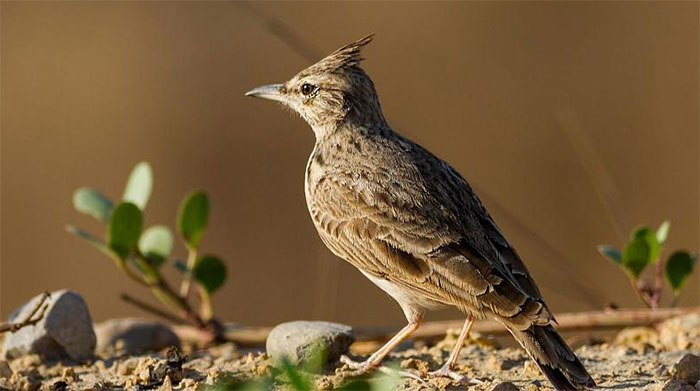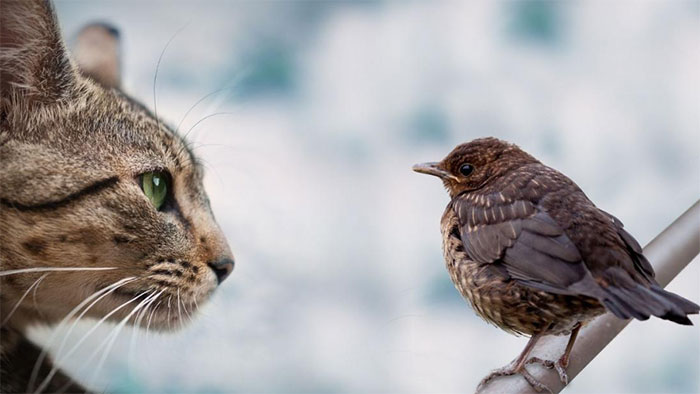The Walldorf town government (Germany) has recently issued a ban on residents allowing their cats to roam freely or take them for walks. Animal rights advocates are protesting, arguing that this constitutes “animal discrimination” and will lead to cats feeling “lonely and depressed.”
To protect the Eurasian skylark from being preyed upon by cats, the German government has enacted a special ban lasting at least three months. From the end of May until the end of August, cat owners in Walldorf are prohibited from letting their cats roam freely.

Cats are considered perennial enemies of birds and small mammals – (Photo: Canva)
Even taking cats for walks is forbidden. Violators could face fines ranging from 500 euros to as much as 50,000 euros (approximately 1.23 billion VND at current exchange rates) if caught allowing their cats to injure or kill birds.
This regulation has been implemented to help the Eurasian skylark survive its breeding season. This species nests on the ground rather than in trees like other birds, making it particularly vulnerable to cats.
The population of Eurasian skylarks has significantly declined in recent decades. Authorities in Walldorf state that the survival of this bird species depends on the fate of each chick in the upcoming breeding seasons.
As a result, the German government has established this regulation not only for this year but will continue to repeat it for the next three years (from April to August each year) and apply it to all cats (of anyone) in Walldorf. Plans are also in place to capture and confine feral cats.
The ban on allowing cats to roam has faced opposition not only from cat owners but also from animal rights organizations.
On Euronews Green, the Deutscher Tierschutzbund – Germany’s largest animal welfare organization – stated: “There is no solid evidence proving that the decline in the Eurasian skylark population is due to cats preying on them. Blaming them is unfair. Suddenly confining cats that are used to going outside is akin to ‘social distancing.’ This will cause stress and depression for them.“
The Deutscher Tierschutzbund supports measures to protect the Eurasian skylark but argues that “no species should be prioritized over another. Animals also deserve fairness.”

Eurasian skylarks typically nest on the ground – (Photo: Canva)
Other animal rights activists have also expressed that banning cats from going outside due to fears of them preying on birds is essentially blaming them and making them bear the responsibility. Meanwhile, humans are the true culprits who have long destroyed habitats and food sources for wildlife.
Daniela Schneider, an advocate for Four Paws Germany – a global animal welfare organization focused on animals impacted directly by humans, stated: “The effects of intensive agriculture, monoculture, lack of insects, and industrial land development are the main causes of the decline in the Eurasian skylark population. It would be better to look at the actual causes created by humans rather than blaming cats for this.”

Animal rights advocates oppose the ban on allowing cats to roam, claiming it is “animal discrimination” and will lead to cats feeling “lonely and depressed” – (Photo: Canva)
Local animal protection organizations and associations are planning to take legal steps to challenge this ban, seeking justice for cats. Cat owners affected by the new regulation (such as proving that their cats are depressed from being confined indoors) can also exercise their right to protest until mid-June.
The debate over whether cats should be allowed to roam freely is attracting attention not only from the German public. The European pet food industry estimates that 26% of households in Europe own at least one cat.
A study in 2013 estimated that free-roaming pet cats in the U.S. alone kill about 2.4 billion birds and 12.3 billion small mammals each year.
The latest data from the Mammal Society indicates that cats in the UK can catch up to 100 million small animals during spring and summer, including 27 million birds. The most commonly caught birds are house sparrows, European robins, skylarks, and starlings.
Despite these statistics, the largest animal conservation charity in the UK, the RSPB, also stated that there is no clear scientific evidence that cats are the main cause of the decline in bird populations.


















































